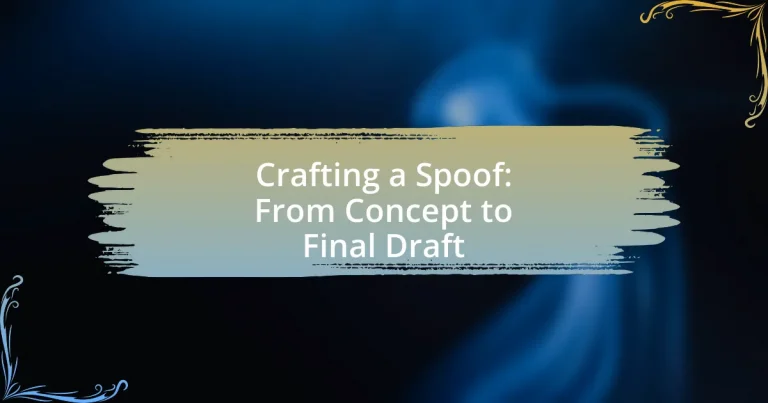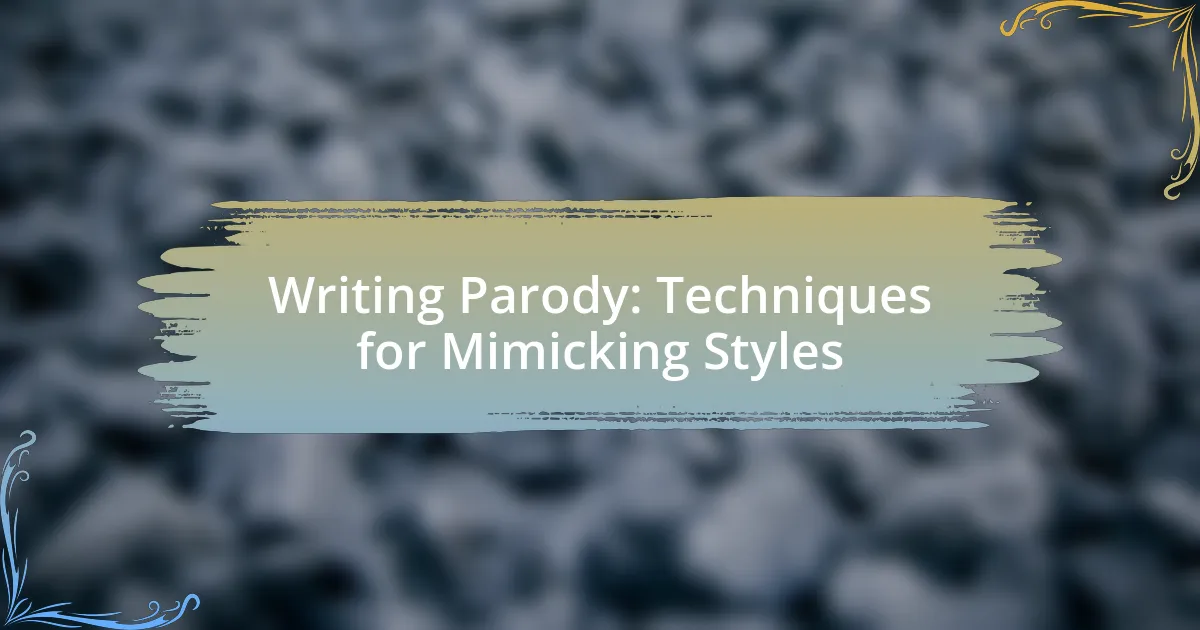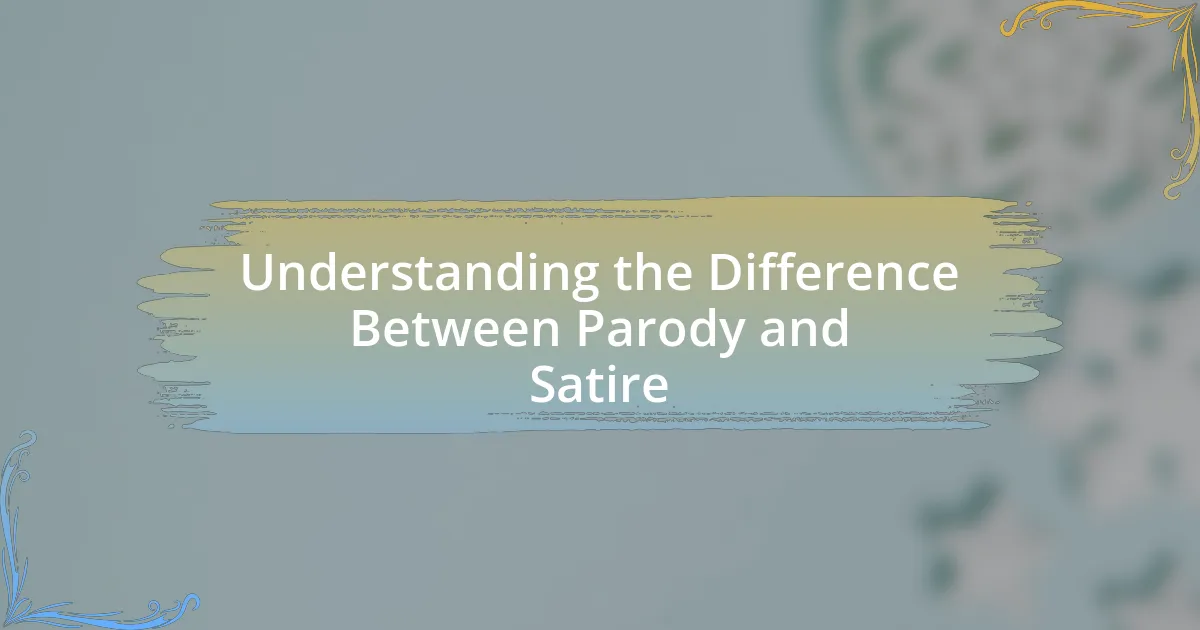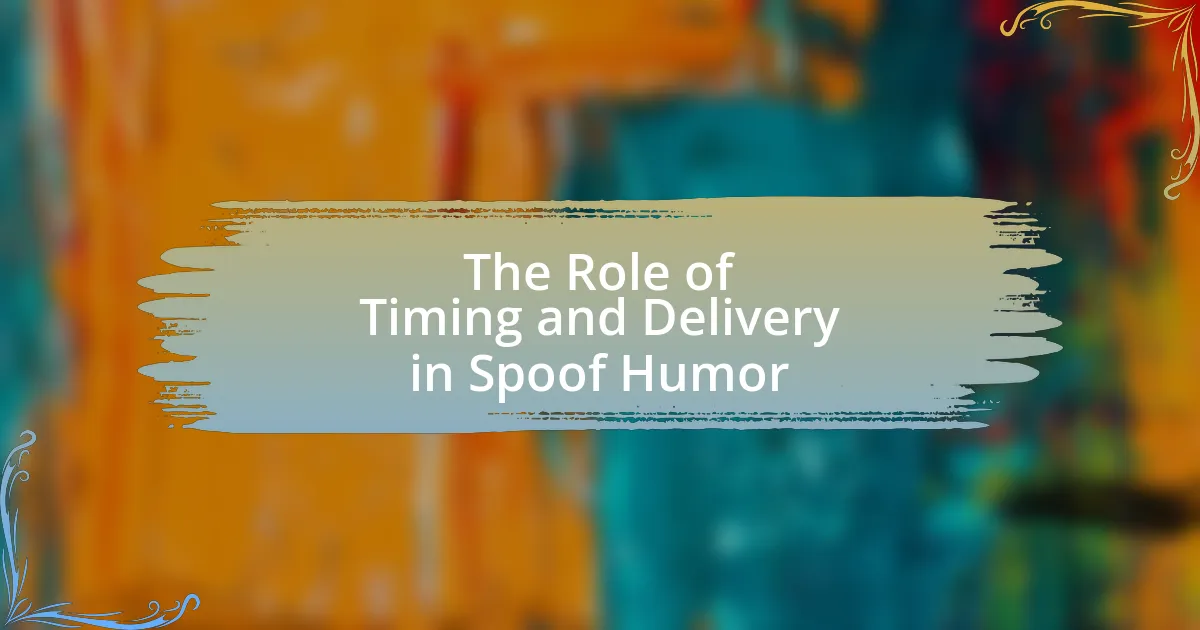Crafting a spoof involves creating a humorous or satirical imitation of a specific work, genre, or style, aimed at entertaining or critiquing the original material. The process begins with identifying a target subject, understanding its conventions, and exaggerating elements for comedic effect. Key components of a successful spoof include a clear premise, exaggerated characters, humorous dialogue, and a satirical plot, all tailored to resonate with the target audience. Various techniques, such as brainstorming and feedback, are essential for refining humor and ensuring effective comedic timing throughout the drafting process. This article provides a comprehensive guide on the steps and strategies involved in crafting a spoof, from concept development to final draft completion.
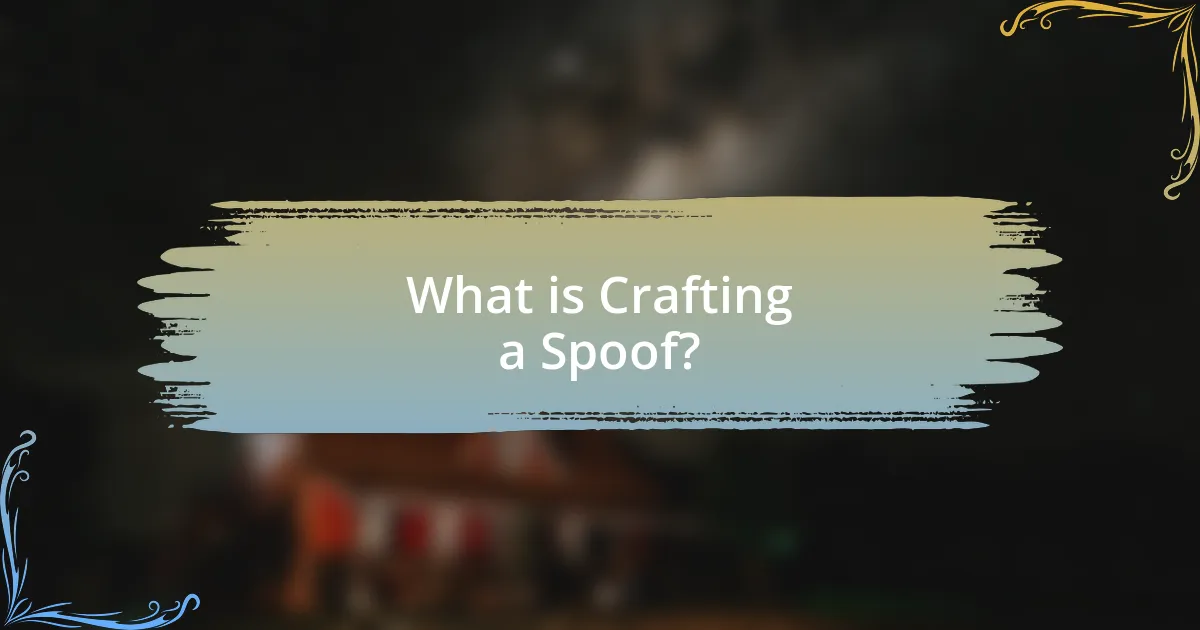
What is Crafting a Spoof?
Crafting a spoof involves creating a humorous or satirical imitation of a particular work, genre, or style, often to entertain or critique. This process typically includes identifying the original source material, understanding its conventions, and then exaggerating or twisting those elements to produce comedic effect. For instance, successful spoofs like “Scary Movie” parody horror films by amplifying their clichés and tropes, demonstrating how the technique can effectively engage audiences while providing commentary on the original content.
How does the process of crafting a spoof begin?
The process of crafting a spoof begins with the identification of a target subject or theme that is ripe for satire. This initial step involves selecting a cultural phenomenon, trend, or specific work that can be humorously exaggerated or critiqued. For instance, successful spoofs often draw inspiration from popular films, television shows, or societal norms, allowing creators to leverage existing familiarity for comedic effect. By establishing a clear target, the spoof can effectively highlight absurdities or contradictions, making the humor more relatable and impactful.
What are the key elements that define a spoof?
A spoof is defined by its use of humor, exaggeration, and parody to imitate and satirize a specific genre, work, or cultural phenomenon. Key elements include a recognizable target, comedic exaggeration of characteristics, and a playful tone that invites the audience to recognize the absurdity of the original subject. For instance, films like “Scary Movie” parody horror films by amplifying their clichés, making the humor accessible through familiar tropes. This combination of elements effectively engages the audience while critiquing the original material.
Why is understanding the target audience important in spoof crafting?
Understanding the target audience is crucial in spoof crafting because it directly influences the effectiveness and reception of the spoof. By knowing the audience’s preferences, cultural references, and humor styles, creators can tailor their content to resonate more deeply, ensuring that the spoof is relatable and engaging. For instance, a study by the University of Southern California found that humor that aligns with audience demographics significantly increases viewer enjoyment and shareability. This alignment enhances the spoof’s impact, making it more likely to achieve its intended comedic effect and reach a wider audience.
What are the different types of spoofs?
The different types of spoofs include parody, satire, and hoax. Parody mimics the style of a particular genre or work to create humor, often exaggerating characteristics for comedic effect. Satire critiques societal norms or behaviors through humor, aiming to provoke thought or change. Hoaxes involve deception, presenting false information as truth to mislead an audience, often for entertainment or social commentary. Each type serves distinct purposes in entertainment and commentary, contributing to the broader landscape of spoofing in media.
How do parodies differ from other forms of spoofing?
Parodies differ from other forms of spoofing primarily in their intent and execution, as parodies specifically aim to imitate and exaggerate the style or content of a particular work to comment on or critique it. Unlike general spoofing, which may simply mimic for humor or entertainment without a deeper commentary, parodies often incorporate satire, targeting the original work’s themes, characters, or conventions to provoke thought or highlight absurdities. For example, “Weird Al” Yankovic’s song parodies not only mimic the musical style of the original artists but also provide humorous commentary on the subject matter, showcasing the distinct purpose of parody compared to broader spoofing techniques.
What role does satire play in crafting a spoof?
Satire serves as a foundational element in crafting a spoof by using humor and exaggeration to critique or mock its subject. This form of satire allows creators to highlight absurdities, inconsistencies, or flaws in the original material, making the spoof both entertaining and thought-provoking. For instance, the use of parody in works like “Saturday Night Live” effectively demonstrates how satire can amplify the comedic impact while simultaneously delivering social commentary. By employing satire, a spoof not only entertains but also encourages audiences to reflect on the original content and its broader implications.
Why is the concept phase crucial in crafting a spoof?
The concept phase is crucial in crafting a spoof because it establishes the foundational ideas and themes that will guide the entire project. This phase allows creators to define the target audience, identify key comedic elements, and outline the narrative structure, ensuring that the spoof effectively resonates with viewers. By solidifying these elements early on, creators can avoid inconsistencies and enhance the overall coherence of the spoof, leading to a more impactful and engaging final product.
What techniques can be used to brainstorm spoof ideas?
Techniques to brainstorm spoof ideas include mind mapping, free writing, and role-playing. Mind mapping allows individuals to visually organize thoughts and connections related to the spoof concept, facilitating the generation of diverse ideas. Free writing encourages spontaneous expression without self-censorship, often leading to unexpected and humorous angles. Role-playing involves adopting different perspectives or characters, which can inspire unique scenarios and comedic elements. These techniques are effective as they promote creativity and divergent thinking, essential for developing engaging spoof content.
How can existing media influence the concept of a spoof?
Existing media significantly influences the concept of a spoof by providing cultural references, stylistic elements, and thematic frameworks that can be parodied. For instance, popular films, television shows, and viral internet content serve as a backdrop for humor, allowing creators to draw on recognizable tropes and scenarios that audiences can easily identify. This intertextuality enhances the comedic effect of a spoof, as it relies on the audience’s familiarity with the original material to create humor through exaggeration or absurdity. Historical examples include “Scary Movie,” which parodies horror films, and “The Simpsons,” which often satirizes contemporary culture, demonstrating how existing media shapes the structure and content of spoofs.
How do you transition from concept to script in spoof crafting?
To transition from concept to script in spoof crafting, begin by outlining the core idea and identifying key comedic elements that will drive the narrative. This involves breaking down the concept into scenes, ensuring each scene contributes to the overall humor and plot progression. For instance, if the spoof targets a specific genre or film, analyze its tropes and exaggerate them for comedic effect.
Next, develop character profiles that embody these exaggerated traits, as strong characters enhance the humor and relatability of the script. Incorporate dialogue that reflects the absurdity of the situations, using puns, wordplay, and references that resonate with the audience.
Finally, revise the draft to tighten the pacing and enhance comedic timing, ensuring that each joke lands effectively. This structured approach, supported by the principles of comedic writing, facilitates a smooth transition from concept to a cohesive script.
What are the essential components of a spoof script?
The essential components of a spoof script include a clear premise, exaggerated characters, humorous dialogue, and a satirical plot. A clear premise establishes the central idea or theme that the spoof will parody, while exaggerated characters amplify traits for comedic effect. Humorous dialogue is crucial for delivering jokes and witty exchanges that resonate with the audience. Lastly, a satirical plot weaves these elements together, often mimicking the structure of the original work being spoofed, to create a cohesive and entertaining narrative. These components work in tandem to effectively convey humor and critique, making the spoof engaging and relatable.
How do character development and dialogue contribute to a successful spoof?
Character development and dialogue are essential for a successful spoof as they create relatable and exaggerated personas that enhance comedic effect. Well-developed characters allow audiences to recognize familiar traits from the original material being spoofed, while sharp, witty dialogue amplifies humor through clever wordplay and situational irony. For instance, in the film “Scary Movie,” the characters are exaggerated versions of horror film archetypes, and their dialogue often parodies iconic lines, making the humor accessible and engaging. This combination of relatable character traits and humorous dialogue not only entertains but also critiques the original genre, solidifying the spoof’s effectiveness.
What structural elements should be included in a spoof script?
A spoof script should include the following structural elements: a clear premise, character archetypes, exaggerated scenarios, comedic dialogue, and a resolution. The premise establishes the central theme or concept being parodied, while character archetypes, such as the hero, villain, and sidekick, provide recognizable roles that enhance humor. Exaggerated scenarios amplify the absurdity of the original material, and comedic dialogue delivers punchlines and witty exchanges that drive the humor. Finally, a resolution ties up the narrative, often with a humorous twist that reinforces the parody. These elements collectively create an effective spoof that resonates with audiences familiar with the source material.
What are the common challenges faced during the drafting process?
Common challenges faced during the drafting process include writer’s block, lack of clarity in ideas, and difficulty in maintaining a coherent structure. Writer’s block can hinder progress, as it prevents the writer from generating new content. Lack of clarity in ideas often leads to confusion, making it hard to articulate thoughts effectively. Additionally, maintaining a coherent structure is crucial; without it, the draft may become disorganized, making it difficult for readers to follow the narrative. These challenges are frequently encountered by writers at all levels, impacting the overall quality and effectiveness of the final draft.
How can writers overcome writer’s block when crafting a spoof?
Writers can overcome writer’s block when crafting a spoof by employing techniques such as brainstorming, free writing, and engaging in collaborative discussions. Brainstorming allows writers to generate a wide range of ideas quickly, which can spark creativity and lead to humorous concepts. Free writing encourages writers to write continuously without self-editing, helping to bypass mental barriers and unlock new angles for satire. Collaborative discussions with peers can provide fresh perspectives and inspire new directions for the spoof, as humor often thrives in a social context. These methods are effective because they shift the focus from perfectionism to exploration, fostering a more playful and open-minded approach to writing.
What strategies can be employed to refine humor in the draft?
To refine humor in a draft, writers can employ strategies such as testing jokes with a target audience, revising punchlines for clarity and timing, and incorporating relatable scenarios. Testing jokes with a target audience provides immediate feedback on what resonates, ensuring the humor aligns with audience expectations. Revising punchlines enhances their effectiveness by focusing on brevity and impact, as studies show that concise humor often elicits stronger reactions. Incorporating relatable scenarios increases the likelihood of audience connection, as humor rooted in shared experiences tends to be more effective.
What best practices should be followed when finalizing a spoof draft?
When finalizing a spoof draft, it is essential to ensure clarity, coherence, and humor alignment with the intended audience. Clarity involves reviewing the draft for any ambiguous language or confusing plot points, ensuring that the humor is easily understood. Coherence requires checking the flow of the narrative, making sure that all elements connect logically and contribute to the overall comedic effect. Additionally, humor alignment means assessing whether the jokes and comedic elements resonate with the target audience’s preferences and cultural references.
Proof of these best practices can be found in writing guides such as “The Comic Toolbox” by John Vorhaus, which emphasizes the importance of clarity and audience awareness in comedic writing. Furthermore, studies in humor theory suggest that effective humor often relies on shared understanding and context, reinforcing the need for coherence and audience alignment in the final draft.
How important is feedback in the final stages of crafting a spoof?
Feedback is crucial in the final stages of crafting a spoof as it helps refine the humor, clarity, and overall impact of the piece. In this phase, creators can identify any misinterpretations or weak points that may not resonate with the audience. Research indicates that incorporating feedback can enhance the effectiveness of comedic elements, as humor often relies on audience perception and relatability. For instance, a study published in the Journal of Communication found that audience feedback significantly improved the reception of comedic content, demonstrating the importance of external perspectives in achieving the desired effect.
What techniques can enhance the comedic timing in the final draft?
Techniques that can enhance comedic timing in the final draft include the use of pacing, punchline placement, and rhythm. Pacing involves controlling the speed at which jokes are delivered, allowing for pauses that build anticipation and maximize impact. Punchline placement is crucial; placing the punchline at the end of a setup or after a brief pause can create a stronger comedic effect. Rhythm refers to the flow of dialogue and action, where varying sentence lengths and structures can create a musical quality that enhances humor. Research in comedy writing emphasizes that timing is often as important as the content of the joke itself, with studies showing that well-timed delivery can significantly increase audience laughter.
What tips can help ensure a successful spoof creation?
To ensure a successful spoof creation, focus on developing a strong concept that resonates with the audience’s sense of humor. A well-defined premise allows for effective satire and comedic elements that engage viewers. Additionally, incorporating relatable characters and situations enhances the spoof’s appeal, as audiences connect better with familiar themes. Research shows that successful spoofs often parody recognizable tropes, which can amplify comedic impact. For instance, the film “Scary Movie” effectively parodied horror clichés, leading to significant box office success. Thus, a clear concept, relatable elements, and effective parody are essential for crafting a successful spoof.
